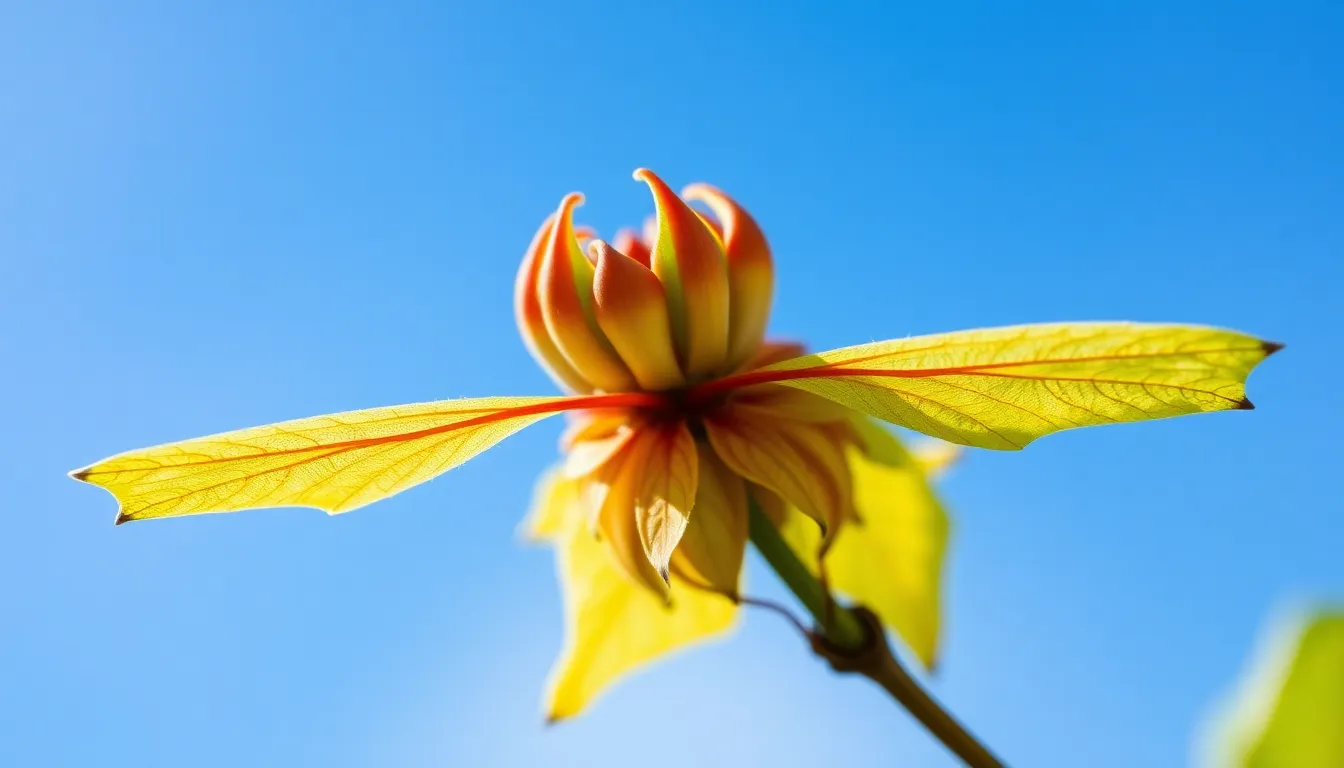Nature’s wonders often come in fascinating forms, and one of the most intriguing is the “helicopter seed.” These unique seeds spin gracefully to the ground, resembling miniature helicopters in flight. But what tree produces these captivating seeds?
The answer lies in the maple tree, specifically species like the Norway and sugar maple. These trees are known for their distinctive winged seeds, scientifically called samaras. As they fall from the tree, the seeds twirl and glide, ensuring they disperse widely, which helps the tree thrive in various environments. Understanding the role of these seeds not only highlights the beauty of maple trees but also showcases the complexity of nature’s reproductive strategies.
Table of Contents
ToggleOverview of Helicopter Seeds
Helicopter seeds, commonly referred to as samaras, exhibit a unique structure that enhances their dispersal. Maple trees, such as the Norway maple (Acer platanoides) and sugar maple (Acer saccharum), produce these seeds. The wing-like extensions enable the seeds to spin as they descend, mimicking a helicopter’s rotor blades.
These seeds play a crucial role in the reproductive cycle of trees. The aerodynamic design allows them to travel significant distances from the parent tree, reducing competition for resources. When conditions favor growth, samaras can germinate quickly, giving rise to new saplings.
This fascinating adaptation not only supports the survival of maple trees but also contributes to the overall health of forest ecosystems. Various factors, including wind patterns and humidity, affect the dispersal efficiency of these seeds, showcasing the complexity of nature’s design.
Common Trees with Helicopter Seeds

Several tree species exhibit helicopter seeds, known for their distinct samara structure. The following trees produce these fascinating seeds, enhancing natural dispersal.
The Norway Maple
The Norway maple (Acer platanoides) produces large, double-winged samaras. These seeds spin as they fall, allowing them to travel distances up to 100 feet from the parent tree. Norway maples thrive in urban environments and can tolerate pollution, making them popular ornamental trees. Their seeds mature in late summer to early fall.
The Silver Maple
The silver maple (Acer saccharinum) features elongated, light green samaras that turn a pale yellow-brown when mature. These seeds typically flourish in moist, well-drained soils and disperse through wind currents. Silver maples are fast-growing trees, often reaching heights of 50 to 80 feet, and their seeds can glide several hundred feet away from the trunk.
The Boxelder
The boxelder (Acer negundo) is another tree that produces helicopter seeds. Its samaras are smaller and appear in clusters, forming a unique appearance. Boxelders grow rapidly and often inhabit areas with varied moisture levels. These trees can reach heights of 30 to 60 feet, with seeds enabling their reproduction across extensive areas quickly.
The Science Behind Helicopter Seeds
Helicopter seeds, produced by maple trees, feature a distinct aerodynamic design that supports their dispersal and enhances species survival. Understanding their mechanics and advantages reveals the complexity of their role in nature.
How They Work
Helicopter seeds, or samaras, utilize their wing-like structure to achieve controlled descent. As they fall, the seeds spin, creating lift and increasing airborne time. This rotation mimics rotor blades, allowing the seeds to travel distances of up to 100 feet or more from the parent tree. Wind variations significantly influence their paths, helping the seeds settle in favorable environments for germination.
Advantages of Helicopter Seeds for Trees
Helicopter seeds offer several benefits for the survival of tree species. The aerodynamic design maximizes dispersal efficiency, reducing competition among seedlings for light, water, and nutrients. Rapid germination follows favorable conditions, allowing young saplings to establish quickly. The diversity in samara structure among different species aids in colonizing various habitats, including urban areas and moist soils, contributing to a robust ecosystem. By enhancing genetic diversity and adaptability, helicopter seeds play a crucial role in maintaining healthy forests.
Importance of Helicopter Seeds in Ecosystems
Helicopter seeds play a vital role in maintaining the health and diversity of ecosystems. These unique samaras enable effective dispersal of tree species, fostering genetic diversity and adaptability within forest environments. Enhanced genetic diversity allows trees to withstand pests, diseases, and climate fluctuations, ensuring ecosystem resilience.
Samaras minimize competition for resources among seedlings by dispersing over considerable distances from the parent tree. Efficient dispersal promotes the establishment of saplings in nutrient-rich and suitable habitats. By colonizing various environments, helicopter seeds facilitate the growth of diverse plant communities, contributing to stronger ecosystems.
The aerodynamic design of helicopter seeds ensures they remain airborne longer, allowing them to travel up to 100 feet or more. Wind conditions influence their trajectories, directing seeds to areas with optimal sunlight, moisture, and soil type necessary for germination. This adaptation ensures that new saplings have a higher chance of survival.
Helicopter seeds also support interactions within ecosystems. They provide food for birds and small mammals, integrating into local food webs. As saplings mature, they contribute to forest structure, offering habitat for various wildlife species. The interaction between helicopter seeds and other elements of the ecosystem enhances nutrient cycling and promotes soil health.
Helicopter seeds are crucial for the reproductive success of trees, influencing ecosystem structure and function. Their role in genetic diversity, resource allocation, and wildlife interactions underscores the importance of these remarkable seeds in sustaining healthy forest ecosystems.
Helicopter seeds are a remarkable adaptation found in maple trees that showcase nature’s ingenuity. These samaras not only facilitate the dispersal of seeds but also enhance the survival and growth of new saplings in diverse environments. By minimizing competition and promoting genetic diversity, helicopter seeds play an essential role in maintaining healthy forest ecosystems.
As these winged seeds glide through the air, they contribute to the intricate balance of nature, supporting wildlife and enriching soil health. Understanding the significance of these seeds helps appreciate the complex relationships within ecosystems and the vital functions trees perform in our environment.



